|
Ladders are a simple tool for gaining access to higher levels. When properly used and cared for, they will provide many years of useful service. Ladders are built of several different materials and in various designs. The merits of these types are as follows: Solid Beam: Wood  Truss Beam: Wood Again, remember: The size of the side rail must increase as the length increases--just to carry an equal load. 
Wood Rungs Advantages of Wood Ladders 
Disadvantages of Wood Ladders Remember: The varnish finish is only good as long as it remains intact. When the varnish becomes damaged, the wood is now open to the elements and drying and splitting can start. It is recommend that the varnish finish be checked at least every six months and redone annually to preserve the wood. The useful life span of a wood ladder can be as short as a few years or as long as ten years or more--depending upon its usage and the maintenance it receives. Wood ladders stored near a heating source or in the direct rays of the sun, even though inside a building, should be very carefully checked and refinished at least annually. Note: Your health and life are at stake when you use any ladder. Be sure the ladder is fit to use before you use it. 
FIBERGLASSFiberglass ladders are a recent addition to the ladder market. Fiberglass is a man made material that does not conduct electricity when dry. For this reason it is generally compared to wood models. Fiberglass ladders are generally all of the solid beam type with connecting rungs of fiberglass or aluminum at regular intervals. These rungs are jointed to the side rails either by rivets or expansion plugs through the side rails in most cases. Fiberglass ladders generally are not readily available in longer lengths due to the weight involved, as fiberglass is more dense and therefore heavier than the equal size wood construction. Advantages of Fiberglass 
Generally, glass ladders do not require a protective finish to preserve them. The worst that normally occurs with age is a slow fading of colour and ultra-violet erosion of the surface, similar to surface deterioration found on fiberglass boats. Even though most fiberglass ladders use aluminum rungs, you will not find any connection of metal between the rungs. Therefore it is still a non-conductor of electricity. Disadvantages of Fiberglass ALUMINUM LADDERSAluminum ladders are again divided into the two basic types of construction as wood models, i.e. solid beam and truss construction. 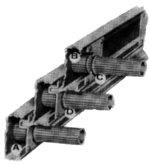
Solid Beam Aluminum Construction: These types of ladders use a solid side rail beam with aluminum rungs connecting at regular intervals. The aluminum rungs generally connect to the side rails either by a welded joint between rung and side rails, or by an extension plug pinching the rung tightly to the side rails and internal back-up plates. The expansion plug method makes rung replacement very easy and also provides an easy method by which to tighten any rungs that have loosened by wear or tear. The welding method always requires re-welding when rung replacement is necessary, but with welded rungs there never is a loose rung problem unless the side rails are torn through a rung. In this case we recommend replacement of the entire section of ladder. Remember: As with wood or fiberglass models, even aluminum side rails must increase in size as the ladder length gets longer. Without this increase in side rail size the load capacity will decrease as the length of the ladder increases. Aluminum Truss Construction Advantages of Aluminum Ladders 
Caution: Aluminum Ladders Conduct Electricity Beware: If your aluminum ladder has been subjected to extreme heat exposure at a fire even for a brief period, it may have become annealed and no longer has the load capacity it had even minutes ago. Once aluminum ladders have been exposed to extreme heat they probably have lost their heat treatment and have become annealed. This means the load capacity may be greatly reduced even though the metal shows no sign of any change. It is recommend that you purchase and place heat sensing labels on the upper section of your aluminum ladders. These labels turn color when the temperature gets to their pre-set heat range. After every use these labels should be checked to be sure the aluminum has not weakened. If a heat sensing label had changed color after usage, we suggest you remove the ladder from service and replace it. Beware: When a fire crowns on the lower floor and your aluminum ladder is engulfed in flame, this ladder probably will no longer support even one man. Remember: The ground ladders on your fire truck may be, and often are, the only means of escape for both the private citizen who is trapped and the fireman who is attempting to do his job. GENERAL PARTSLadders in general have only a few working parts other than the multiple sections that comprise the entire ladder. Pulleys are found on all extension ladders of two or more sections. These pulleys are normally supplied with a ball bearing center which requires a small drop or two of oil approximately once a year to remain smoothly operational. The ropes that are supplied on extension ladders are generally pure Manila of sufficient size to raise the sections. When the rope becomes frayed or twisted from usage, it should be replaced. Manila rope is used for its overall characteristics of soft and strong material without excessive stretch or shrinkage under temperature extremes. When an extension ladder is raised, it is recommended that the rope be tied off to the lower section of the ladder as a safety measure to insure the ladder locks are not accidentally unlocked by a pull on the rope. LADDER LOCK ASSEMBLIESLock assemblies are commonly of two types: The above facts plus the fact that all pulleys and cables are always strung from a lower section to a fly section, makes it clear that not only are the lock assemblies given a better chance to work in the fly up position, but there is simply less things to trip over in the fly up position. Use the ladder as it was designed to be used, not what ever way is the easiest. Mechanical lock assemblies are generally spring loaded devices. These springs have been known to break or rust off. It is recommended that lock assemblies be kept clean and oiled, not only to save your own life and limb, but to make sure your equipment has the best possible chance of proper function when it is assumed to be ready to function. You should request a lock housing repair kit from the ladder manufacturer whenever you are going to repair and/or recondition your lock assemblies. This kit gives complete information on how to remove, rebuild and install the assemblies so proper lock action is maintained. 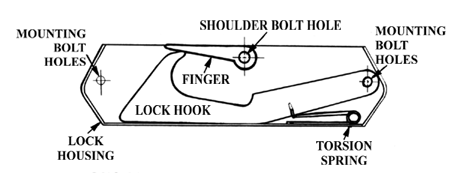 FIG. A--View of Lock Housing Showing Parts  ROOF HOOKS ROOF HOOKS
These are spring loaded and covered assemblies to insure operation even under freezing conditions. It is recommended that once rust is noted on these assemblies they are taken apart and cleaned, painted and oiled so proper function can occur. Roof hooks in general are used to secure the ladder over the peak of a roof or to hang from a wall edge or window opening. Be sure the bolts are secure on the roof hooks and the hooks have not been accidentally bent open. 
PRONG FEET OR SAFETY SHOESA double edge steel prong foot is supplied on all ground ladders to prevent slippage when the ladder is in use. The prong foot has double edges so the ladder may be used with either surface up. It is recommended that a rubber safety shoe also be used if the ladder is to be positioned on a hard surface such as concrete. Steel prong feet simply do not hold well on hard surfaces. In any case, for fire or rescue work it is recommended that an extra person be used to foot the ladder to insure it remains standing without slippage. TOP END CAPSRound steel end caps are provided on the top end of all sections of all ladders to provide a rounded surface so the tip of the ladder may be slid up a wall without damage to the ladder section. Note: 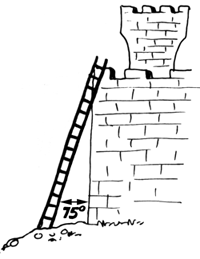
LADDER CLIMBING ANGLEProper climbing angle for a ground ladder is approximately 75°. Place the base of the ladder a distance of ¼ the length extended. Less than this angle lowers the capacity of the ladder, and a closer position increases your chances of falling off as the angle is too steep. PROPER SLIDING OF LADDER SECTIONSThe only proper substance used to make ladder sections properly slide upon each other is candle wax or grease. Grease is normally only used for internally guided aluminum truss models and should be cleaned and recoated every year. In all cases, plain candle wax applied every six months or so to all contacting surfaces between multiple section ladders is a must for smooth operation. Any wax that is thinner than candle wax is either absorbed by the ladder material or rubbed off almost immediately. The net result is no lubrication and the sections do not slide easily. If candle wax will not make your sections slide, we suggest you check your ladder for damages and/or alignment of sections. GENERAL COMMENTSLadders are designed for climbing and for any usage other than this, we suggest you contact the manufacturer for their recommendations. Multiple section models in general are not made to be taken apart and used as single section ladders. The upper sections normally are not furnished with any type of safety foot, and because of this are very prone to slip when used as a single ladder. Ladders should never be used with the round ends down as this is upside down and not only will the ladder slip on the ground, but the lock assemblies cannot possible function properly. 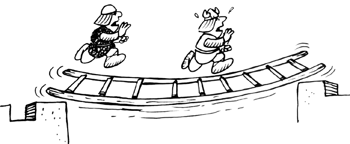 BRIDGING WITH LADDERSIf your department may ever have the possibility of using their ground ladders to bridge two buildings, we suggest they first test the load carrying ability of the ladders they might have to use. Simply set up a pair of saw horses approximately three feet high and fully extend the questioned ladder. Carefully put your man in the center and let him try the ladder for its feel. Remember: It is better to find your problems three feet above the ground rather than three stories up. TESTINGWe recommend any fire department that is considering testing their ground ladders to secure a copy of NFPA specs on ground ladders for reference on their test requirements. The following factory recommended tests are general ladder strength tests as performed at the factory at random to spot check production models. CAUTIONBe careful when testing ladders to avoid shock loads when loading test weights/or falling weights when a ladder fails. Use 50 lb. sand bags for test loads as sand bags will not crush toes when dropped. Ladders should be tested annually and test records be kept permanently. All ladders, except folding and pompier ladders, shall be placed as in diagram A (fully extended). 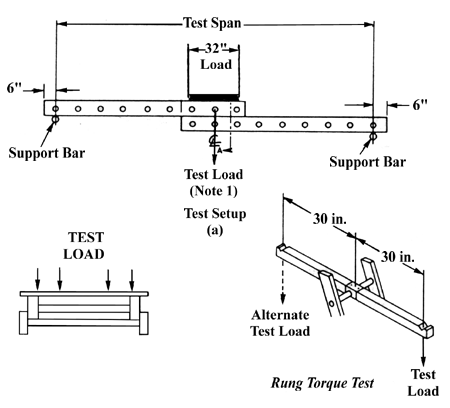
PRE-LOAD
RUNG TORQUE TESTWith the ladder in any convenient position any rung shall pass the following:
ROOF HOOK TEST
There are many more tests possible, but for the sake of reliable service life the aforementioned tests cover the major areas of concern. Other tests beyond this scope are better left to factory or professional testing personnel. If your service ladders can pass these tests you can be sure at that point in time your ladders have a minimum 500 lb. load capacity with a 4:1 safety factor. REMEMBER, if you get in trouble with or on a ladder, chances are very good you will be hurt. It makes a lot of sense to be knowledgeable concerning ladders as you risk your life and limb every time you use a ladder. Choose your ladders to fit your needs and know all the regulations that cover the usage of these ladders. If your only ladder need is to store feathers on the top shelf, get a step ladder. If you need a ladder for more than one person at a time, and it must be able to operate in all weather conditions at any time of the day or night, get a fire and rescue ladder. Check with the manufacturer to find out at what load the ladder will fail, and be sure your needs never exceed the rating of the ladder. Everyone gets hurt when a ladder is not used properly. FOLDING LADDERSThese models are made in wood and aluminum, and normally are never over 14 feet in length. They have hinges on the rungs so the side rails can be folded together and carried up stairways, etc. Be careful these are narrow and light models and are never meant for more than one person at a time (and not heavy people). These should always be equipped with rubber safety shoes because they are meant for indoor use. TRUCK MOUNTINGIf your ladders are mounted on a truck be sure the brackets fit the ladders. The brackets should hold the ladders tightly and support them at regular intervals so they will not take a set from long periods of non-usage. If your ladders slide into any type of internal racks, be sure there is enough clearance for easy removal and nothing is cutting into any surface of the ladders. REMEMBER, if the ladder brackets fail, you need a new bracket. If the brackets are cutting into the ladders and the ladder fails, you just got hurt. NOTE: Ladder brackets should have some type of soft material as a liner so the ladders are not cut into by the movement against the bracket as the truck rolls. LADDER TIPS
It is suggested all ladder users also consult current ANSI standards covering ladders and also current NFPA-1931 on fire department ground ladders for further helpful information on ladders. When in doubt, write directly to the ladder manufacturer for all current information. |
 GENERAL CONSTRUCTION
GENERAL CONSTRUCTION



